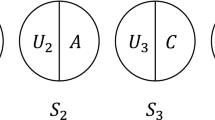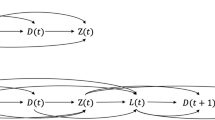Abstract
The sufficient-component cause (SSC) model provides a useful, concise method to conceptualize and organize ideas concerning biologic effects and interactions of multiple factors. Another type of model, the potential outcome or counterfactual models, has also proved useful in epidemiology, providing insights into definitions of effects, exchangeability and confounding, and selection bias. Prior work has shown important links between these two types of models. Here, we show additional connections between the two types of models. We first review basic concepts for both the SSC model and the potential outcome models. We then indicate additional similarities between them, and derive a quantitative link. Our results show that the SSC model actually corresponds to a unique response pattern in a particular potential outcome model. Recognition of the links between the two models should allow greater insight into use of each model, and allow the strengths of both models to be used jointly.
Similar content being viewed by others
References
Rothman KJ, Greenland S (2005) Causation and causal inference in epidemiology Am J Public Health 95(Supp 1): S144–S150
Rothman KJ (1976) Causes Am J Epidemiol 104: 587–592
Rothman KJ, Greenland S (1998) Causation and causal inference. In: Rothman KJ, Greenland S (eds). Modern Epidemiology. Philadelphia, PA: Lippincott, pp. 7–28
Greenland S, Rothman KJ (1998) Concepts of Interaction. In: Rothman KJ, Greenland S (eds). Modern Epidemiology. Philadelphia, PA: Lippincott, pp. 329–342
Kupper LL, Hogan MD (1978) Interaction in epidemiologic studies Am J Epidemiol 108: 447–453
Greenland S, Brumback B (2002) An overview of relations among causal modeling methods Int J Epidemiol 312: 1030–1037
Greenland S, Robins JM (1986) Identifiability, exchangeability, and epidemiological confounding Int J Epidemiol 15(3):413–419
Hernán MA, Hernandez-Diaz S, Robins JM (2004) A structural approach to selection bias Epidemiology 15: 615–625
Greenland S, Poole C (1988) Invariants and noninvariants in the concept of interdependent effects Scand J Work Environ Health 14: 125–129
Koopman JS (1977) Causal models and sources of interaction Am J Epidemiol 106: 439–444
Siemiatycki J, Thomas DC (1981) Biological models and statistical interactions: an example from multistage carcinogenesis Int J Epidemiol 10: 382–387
Acknowledgements
We would like to acknowledge the helpful comments of Dr. Kenneth Rothman. After having written several drafts of the manuscript, we became aware that Dr. James Robins had independently developed some of the same results, with a manuscript in preparation.
Author information
Authors and Affiliations
Corresponding author
Appendix
Appendix
In this Appendix, we consider a single dichotomous risk factor and establish two results. First, given any one-factor potential outcome model and the associated response patterns, these same response patterns can also be obtained from a SSC model (Claim 1). Second, we show that a general SCC model along with population frequencies of its complementary component causes uniquely defines a particular response pattern of a four-factor potential outcome model (Claim 2).
-
Claim 1: For a dichotomous factor “A,” any potential outcome model and the resulting response patterns, there exists a SCC model that defines the same model – the same response patterns. The associated population response pattern frequencies can also be obtained from this SCC model.
-
Proof: The steps in the proof are: (a) define a general potential outcome model for one factor, say A, and the population frequencies for each possible response pattern; (b) define a general SCC model; (c) show that complementary component causes of the SCC and the associated population frequencies can be defined to yield to the response patterns and frequencies as the potential outcome model.
(a) A general Potential Outcome Model for 1 factor
Four response patterns are possible for a single factor, under the potential outcome model framework, as shown in Table 2. The population frequencies of each pattern are given by p i , i = 1, 2, 3, 4, restricted only so that they sum to 1.
(b) A general SCC model for 1 factor
For a single, dichotomous factor (A), the following three sufficient causes are possible:
The three possible complementary component causes can occur in any of eight combinations, which we denote with the vector: (u 1,u 2,u 3), where u i = 1 if complementary component cause i is present and 0 otherwise. If these are the only sufficient causes, then eight combinations of these complementary component causes can occur: (1,1,1), (1,1,0), (1,0,1), (1,0,0), (0,1,1), (0,1,0), (0,0,1), (0,0,0).
(c) Show that complementary component causes of the SCC and the associated population frequencies can be defined to yield to the same response patterns and frequencies as the potential outcome model p 1, p 2, p 3, p 4.
Under the SCC model, the population frequency p i of pattern i, can be expressed in terms of the population frequencies of the complementary component causes as:
Response pattern 1 will occur if and only if U 1&U 2&U 3 or U c1 &U 2&U 3 or U 1&U c2 &U 3 or U c1 &U c2 &U 3or U 1&U 2&U c3 is present (equivalently, if U 1&U 2 or U 3 is present). Thus,
Similarly, for the other response patterns:
Many solutions of Equations (4) and (5) are possible. For example, if p 1 > 0 then we can take:
Thus, for any one-factor potential outcome model, it is possible to define an SCC model which leads to the same response patterns and corresponding population frequencies.
A converse is also possible.
-
Claim 2: A general SCC model along with population frequencies of its complementary component causes uniquely defines a particular response pattern of a four-factor potential outcome model.
-
Proof: This claim follows by a simplified version of the argument in the main text. We first define three functions, f 1, f 2, and f 3 as in Table 3.
For each combination of factors U 1 = u 1, U 2 = u 2, U 3 = u 3, and A = a, we define the function F:
where χ(z) = 1 if z ≥ 1 and 0 otherwise; disease will occur if and only F(u 1, u 2, u 3, a) = 1. The argument that the sufficient-component cause model yields this response pattern now follows using a simplified version of the argument in the main text. Here, 16 combinations of factors (u 1, u 2, u 3, a) are possible, so that 216 response patterns could occur. The SCC model corresponds to the unique response pattern given by Equation 6.
Rights and permissions
About this article
Cite this article
Flanders, W.D. On the relationship of sufficient component cause models with potential outcome (counterfactual) models. Eur J Epidemiol 21, 847–853 (2006). https://doi.org/10.1007/s10654-006-9048-3
Accepted:
Published:
Issue Date:
DOI: https://doi.org/10.1007/s10654-006-9048-3




